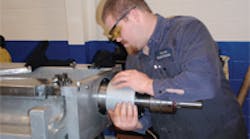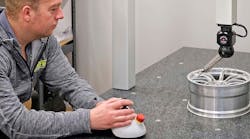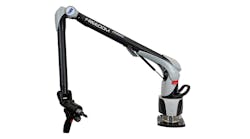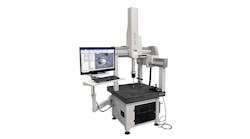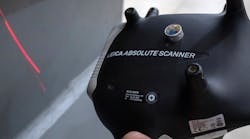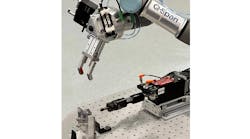By Jim Leigh, co-owner of Pyramid Rebuild & Machine, a Tallmadge, Ohio-based company that specializes in retrofitting, rebuilding and remanufacturing machine tools.
A mechanic inOften when a machine tool has accumulated lots of hours and isn’t functioning with its original precision and reliability, shop owners and plant managers get out the check book and start shopping for a new piece of equipment.
But there are alternatives to plunking down hundreds of thousands of dollars or shouldering serious debt for fresh iron.
If the machine tool in question is a quality piece of equipment, updating it with one of three proven strategies – rebuilding, retrofitting or remanufacturing — is an option.
When undertaken by competent professionals, any of these methods can revitalize a machine tool and can do so for a fraction of the cost of buying new.
Here is a review each of these strategies and its advantages.
Rebuilding consists of providing upgrades and repairs aimed at one goal – restoring a piece of equipment to its original OEM specifications so that it is once again reliable and accurate.
The best machines to rebuild are those that are mechanically sound, well-constructed and possess special qualities such as extreme rigidity, superb precision or the capacity to handle extra large or heavy workpieces.
Typical operations performed during a rebuild include realignment of way surfaces, replacement of all wear items such as leadscrews, ballscrews, bearings, seals and gaskets, and inspection of all other key components and systems.
Those components or systems that fail to meet standards are rebuilt when feasible or replaced.
Retrofitting is another strategy for revitalizing a machine tool.
The dictionary defines retrofitting this way: “to furnish with new or modified parts or equipment not available or considered necessary at the time of manufacture.”
That definition certainly applies to machine tools. A retrofit usually involves replacing an old CNC with a new unit packed with the latest high-tech features to boost speed and accuracy.
These controls generally are easier to operate and are equipped with programming and networking options that enhance productivity. If a new CNC is installed, it’s also a good idea to replace aging servomotors and drives so the full potential of the new control can be realized.
Replacing old, malfunctioning electrical controls with a new PLC (programmable logic control) is another retrofitting tactic that can enhance a machine tool’s capabilities.
Coupled with an LCD monitor or touch screen display, the programmable logic control permits creation of a user-friendly operator interface that simplifies machine control.
A thorough retrofit also includes replacing the machine’s wiring. Older wiring and flexible conduits become brittle with age, and contribute to broken wires and loose connections that may present nightmarish problems when trying to troubleshoot and diagnose malfunctions. Rewiring and replacing the flexible conduits eliminates this problem and results in a more reliable machine tool that is easier to troubleshoot when problems arise.
Finally, there’s remanufacturing, which is the most exhaustive and expensive approach to updating a machine tool.
Remanufacturing uses the original capability and capacity of the machine tool as a benchmark, and seeks to improve one or both aspects by employing many of the procedures called for in a retrofit or rebuild.
The primary benefit of remanufacturing is that it results in a machine tool that performs better than it ever did.
Modifications often are aimed at enhancing feedrates and achieving higher spindle speeds. But not just any machine tool should be considered a candidate for remanufacturing.
The machine tool selected for this process should be of the highest quality. As they say, “You can’t make a silk purse out of sow’s ear.”
Remanufacturing differs from rebuilding in that each component and system of the machine tool is examined and, where possible, simplified and improved. In most cases, axis drive trains are converted to servo-motor and ballscrew, and spindle transmissions are simplified to provide two or three speed ranges with infinite variability within each range.
During remanufacturing, way lubrication systems may be zoned so that only those axes that are moving are supplied with oil. Zoning reduces oil consumption and the amount of tramp oil in coolant systems.
Additionally, hydraulic system requirements often are simplified, resulting in smaller systems that use less energy and less oil. These are just some of the upgrades that may be included in a remanufacturing project.
When it comes to machine tools, the saying “They don’t make ‘em like they used to” certainly holds true.
So before forking over big bucks for a new machine, managers and shop owners who are concerned about the bottom line but also want quality equipment performance should take a close look at the iron they already have on the floor.
It may be an ideal candidate for preserving and updating by rebuilding, retrofitting or remanufacturing.
